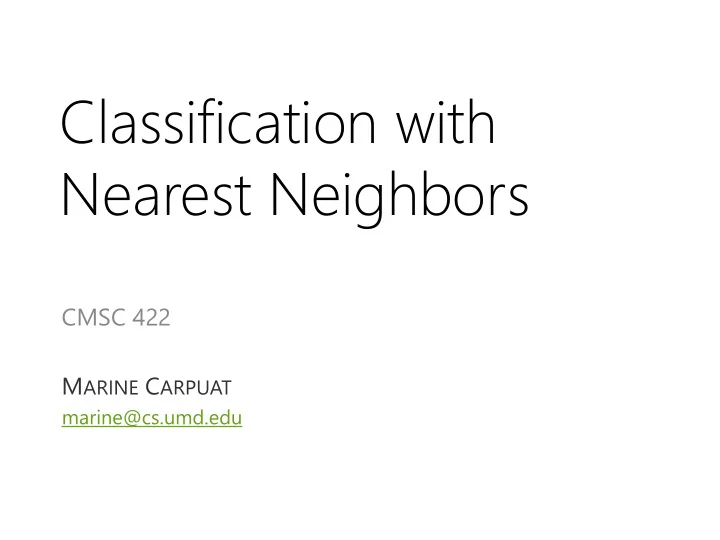

Classification with Nearest Neighbors CMSC 422 M ARINE C ARPUAT marine@cs.umd.edu
What we know so far Decision Trees • What is a decision tree, and how to induce it from data Fundamental Machine Learning Concepts • Difference between memorization and generalization • What inductive bias is, and what is its role in learning • What underfitting and overfitting means • How to take a task and cast it as a learning problem • Why you should never ever touch your test data!!
T oday’s T opics • Nearest Neighbors (NN) algorithms for classification – K-NN, Epsilon ball NN • Fundamental Machine Learning Concepts – Decision boundary
Intuition for Nearest Neighbor Classification This “rule of nearest neighbor” has considerable elementary intuitive appeal and probably corresponds to practice in many situations. For example, it is possible that much medical diagnosis is influenced by the doctor’s recollection of the subsequent history of an earlier patient whose symptoms resemble in some way those of the current patient. (Fix and Hodges, 1952)
Intuition for Nearest Neighbor Classification • Simple idea – Store all training examples – Classify new examples based on most similar training examples
K: number of neighbors that K Nearest Neighbor Classification classification is Test instance with based on unknown class in Training Data { −1; +1 }
2 approaches to learning Eager learning Lazy learning (eg decision trees) (eg nearest neighbors) • Learn/Train • Learn – Induce an abstract model – Just store data in memory from data • Test/Predict/Classify • Test/Predict/Classify – Apply learned model to – Compare new data to stored new data data • Properties – Retains all information seen in training – Complex hypothesis space – Classification can be very slow
Components of a k-NN Classifier • Distance metric – How do we measure distance between instances? – Determines the layout of the example space • The k hyperparameter – How large a neighborhood should we consider? – Determines the complexity of the hypothesis space
Distance metrics • We can use any distance function to select nearest neighbors. • Different distances yield different neighborhoods L2 distance L1 distance Max norm ( = Euclidean distance)
Decision Boundary of a Classifier • It is simply the line that separates positive and negative regions in the feature space • Why is it useful? – it helps us visualize how examples will be classified for the entire feature space – it helps us visualize the complexity of the learned model
Decision Boundaries for 1-NN
Decision Boundaries change with the distance function
Decision Boundaries change with K
The k hyperparameter • Tunes the complexity of the hypothesis space – If k = 1, every training example has its own neighborhood – If k = N, the entire feature space is one neighborhood! • Higher k yields smoother decision boundaries • How would you set k in practice?
What is the inductive bias of k-NN? • Nearby instances should have the same label • All features are equally important • Complexity is tuned by the k parameter
Variations on k-NN: Weighted voting • Weighted voting – Default: all neighbors have equal weight – Extension: weight neighbors by (inverse) distance
Variations on k-NN: Epsilon Ball Nearest Neighbors • Same general principle as K-NN, but change the method for selecting which training examples vote • Instead of using K nearest neighbors, use all examples x such that 𝑒𝑗𝑡𝑢𝑏𝑜𝑑𝑓 𝑦, 𝑦 ≤ 𝜁
Exercise: How would you modify KNN- Predict to perform Epsilon Ball NN?
Exercise: When are DT vs kNN appropriate? Properties of classification Can Decision Trees handle Can K-NN handle them? problem them? Binary features Numeric features Categorical features Robust to noisy training examples Fast classification is crucial Many irrelevant features Relevant features have very different scale
Exercise: When are DT vs kNN appropriate? Properties of classification Can Decision Trees handle Can K-NN handle them? problem them? Binary features yes yes Numeric features yes yes Categorical features yes yes Robust to noisy training no (for default algorithm) yes (when k > 1) examples Fast classification is crucial yes no Many irrelevant features yes no Relevant features have yes no very different scale
Recap • Nearest Neighbors (NN) algorithms for classification – K-NN, Epsilon ball NN – Take a geometric view of learning • Fundamental Machine Learning Concepts – Decision boundary • Visualizes predictions over entire feature space • Characterizes complexity of learned model • Indicates overfitting/underfitting
Recommend
More recommend